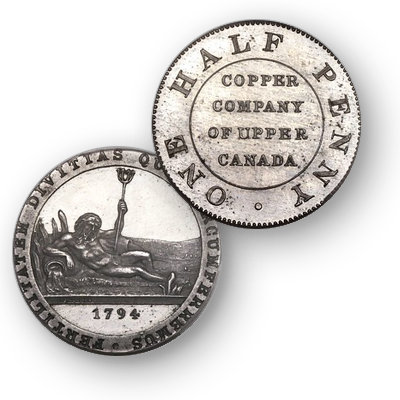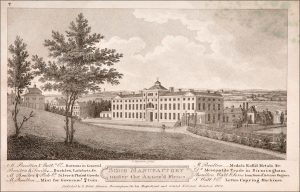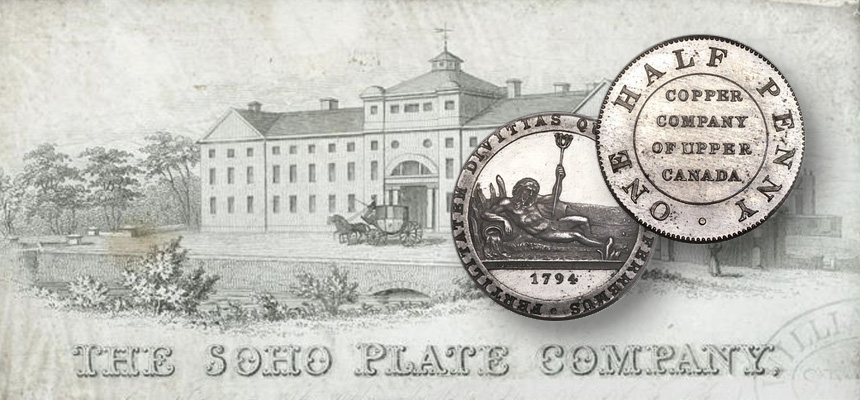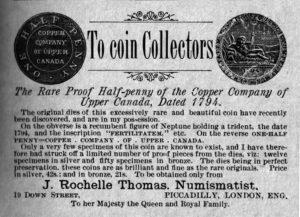The “Copper Company of Upper Canada” Scam
By: MICC Lifetime member #001
In 1894-6, the above ad appeared in North American coin publications such as The American Journal of Numismatics and The Numismatist. As may be seen, the offering purports to be a limited restriking (12 in silver, 50 in bronze) from the original dies of the rare “Copper Company of Upper Canada” halfpenny, dated 1794.
Even at the time, some numismatists greeted this offering with scathing comment, the chief being Dr. W.T.R. Marvin in the ANJ soon after, casting doubt as to whether these were indeed restrikes from the original dies and not just copies. Whether they were or not, Dr. Marvin was of the opinion that restriking should not be done at all and cast aspersions on the business ethics of J. Rochelle Thomas. His letter was reprinted in Spink’s Numismatic Circular of London and Thomas took them to court for “defamation of character”. He won, too, even though a bit of efficient sleuthing should have determined Marvin and Spink’s being correct. It is not known what the exact settlement was; certainly they printed a letter of retraction as part (or all?) of it.

The pieces weren’t cheap (42s and 21s is $10 and $5 respectively at a time when most working men earned not much more than $1 per day) but they sold, chiefly because the restriking was supposed to be so limited. But collectors at the time tended to correspond with one another and it was soon discovered that “12 silver” easily ran to 20 or more – and the supposed “50 bronze” appeared to exist in larger numbers as well. In addition, other off-metal restrikes turned up in brass, tin/white metal/pewter (the same?), lead, aluminum and gold. Those later described as copper, copper bronze, copper gilt and bronzed may all be normal bronze restrikes, perhaps treated. But it was a certainty that the advertised figures and metals were incorrect.
First of all, what were the origins of this piece? We know the originals were struck at Matthew Boulton’s Soho Mint from dies by Noel-Alexandre Ponthon, who was an engraver there 1791-5. And an excellent one he was, too. Even though there have been some wild suppositions of this piece having been an unsuccessful coinage for Governor Simcoe of Upper Canada and so forth, it seems more likely that it was a tour de force of the mint and used by Boulton as a salesman’s sample. Sort of: “see what we can do”. So far as the reverse is concerned, “The Copper Company of Upper Canada” has never been discovered and probably never existed. The name seems to have just been pulled out of the air, Upper Canada being a suitably exotic place at the time. Throughout much of the Nineteenth Century, Canadian collectors sought this fairly rare “coin”. McLachlan had one decades before the Thomas ad appeared.

Engraving of The Soho Manufactory from Stebbing Shaw’s “History and Antiquities of Staffordshire” published in 1801. The caption details the “Annex’d Firms” stating their owners and products: “M Boulton & Buttn. Co. – Buttons in General. M. Boulton – Medals, Roll’d Metals &c. Boulton & Smith – Buckles, latchets &c. Do. Mercantile Trade in Birmingham. M. Boulton & Plate Co. Silver & Plated Goods. Boulton Watt & Sons – Iron Foundy. & Steam Engines. M. Boulton – Mint for Govermt. Coin. J Watt & Co. Letter Copying Machines.” Boulton is given as the sole owner of the Mint. (Image courtesy www.sohomint.info)
At the auction sale of the Soho Mint in 1847(or 48), most of the minting machinery was bought by Ralph Heaton while the dies went to one William Joseph Taylor, a London diesinker. Until well into the 1890s, he and his sons released innumerable numbers of concoctions – many types but each type very scarce to rare. Although he maintained that he had received only a very few dies and many “bits of broken metal” in the lot, the circumstantial evidence in much different. It would seem that he received an unused set of working dies for every issue Soho had struck, preserved in casks by having hot fat poured over them.
The dies were muled every which way; they were struck in off-metals; new “varieties” were created by simply altering one die (an asterisk stop might be punched over a dot in the legend, for instance). He had a good feel for the number he could disperse on the market without harming the considerable price, which was rarely – if ever – less than a guinea (21s or $5). Typically, he would strike only one or two if in gold; roughly 12 if in silver and 25 to 50 in copper. To aid him, he had some sort of working relationship with at least three of London’s more “reputable” coin dealers (J. Rochelle Thomas being one) who were the means by which his wares were dispersed in the collecting world.
But the Copper Company of Upper Canada restrike offered by Thomas in 1794 was only partly a restrike. The reverse is not from the original dies (apparently this had been lost or damaged beyond redemption): the original had round “O”s and no tail to the “R” in the lettering; Thomas’ restrike had oval “O”s and “R”s with the tail turning up. Some numismatists have maintained that the whole “restrike” was a copy, plain and simple – but it was not. The obverse is almost certainly from the original die sunk by Ponthon a century before. For one thing, it carries incused lettering; which means that it was a working die replicated from a master; and Taylor and his sons (W.J. Taylor was dead by 1894) appear unequipped to do more than the simplest of die sinking, alteration and striking.
In recap, it seems as if this “restrike” was actually an original obverse mated with a copied reverse struck by W.J. Taylor & Son in quantities somewhat greater than that advertised and disseminated through the numismatic world by J. Rochelle Thomas, a London coin dealer, serving as a “front” for them. Today, the restrikes are valued in the hundreds of dollars, the originals so rare as to be unpriced.
Previously printed in the MICC Numismatic Journal Vol-02, Issue-05





